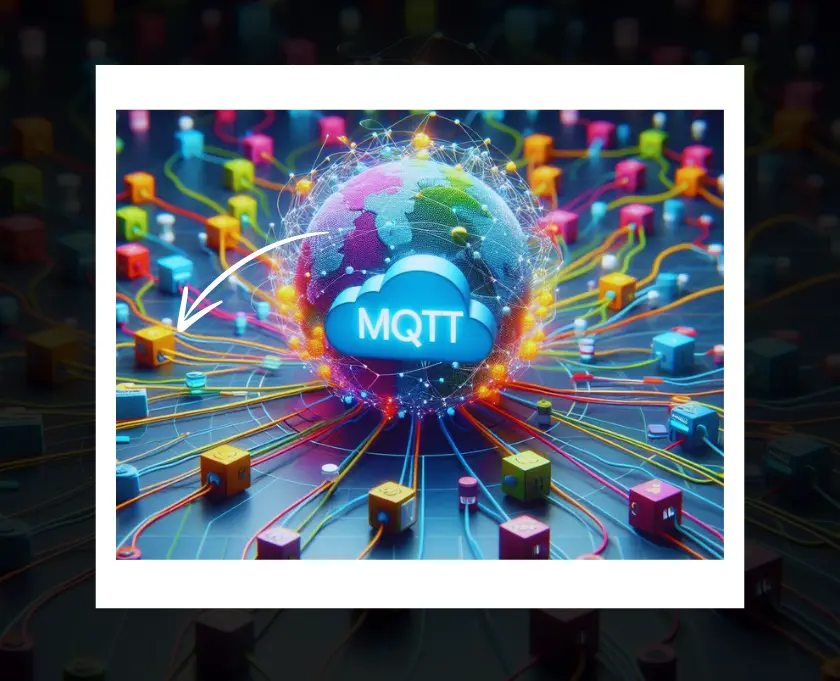![]()
IoT Unlocked: Your Journey to Innovation Starts Now
![]()
IoT Unlocked: Your Journey to Innovation Starts Now

In this blog will cover What is MQTT and How MQTT Works in detailed. In the ever-expanding realm of the Internet of Things (IoT), the need for efficient, reliable, and scalable communication protocols has become paramount.
MQTT (Message Queuing Telemetry Transport) has emerged as one of the most popular protocols to address these needs, especially for devices with limited resources such as the Raspberry Pi Pico W. This blog will delve into the intricacies of MQTT, exploring what it is, how it works, and why it is particularly suited for IoT devices.
MQTT stands for Message Queuing Telemetry Transport. It is a lightweight messaging protocol designed for small sensors and mobile devices, optimized for high-latency or unreliable networks. Developed in the late 1990s by IBM, MQTT is now an open standard under the OASIS organization and widely used in IoT applications for its simplicity and resource efficiency.
MQTT was originally created by Dr. Andy Stanford-Clark of IBM and Arlen Nipper of Cirrus Link Solutions in 1999. The primary goal was to develop a protocol that would enable oil pipeline sensors to communicate over satellite links, where bandwidth was limited and latency was high.
Since its inception, MQTT has evolved significantly and has been adopted across various industries for different IoT applications.
The MQTT architecture consists of two main components: brokers and clients.

The broker is the central hub through which all messages pass. It is responsible for receiving messages from publishers, filtering them based on topics, and delivering them to the appropriate subscribers.
The broker ensures message delivery according to the specified Quality of Service (QoS) levels and handles client connections and disconnections.
Clients are devices or applications that connect to the MQTT broker. They can act as publishers, subscribers, or both. Publishers send messages to the broker on specific topics, while subscribers receive messages from the broker on the topics they are interested in. Clients communicate with the broker over a TCP/IP network.
The MQTT protocol operates on a publish/subscribe model, in contrast to the traditional client/server model. This model allows for decoupling of message producers (publishers) and message consumers (subscribers), enhancing scalability and flexibility.
home/kitchen/temperature).MQTT messages are published on topics, and each topic can have multiple subscribers. Topics are case-sensitive and can include wildcards for flexible subscription patterns.
+): Matches any single level in the topic hierarchy (e.g., home/+/temperature).#): Matches any number of levels (e.g., home/#).MQTT provides three levels of Quality of Service (QoS) for message delivery:
Retained messages are stored by the broker and sent to new subscribers on their initial subscription. This ensures that subscribers immediately receive the last known value of a topic.
LWT allows clients to specify a message that should be sent by the broker if they unexpectedly disconnect. This feature helps other clients detect failures and take appropriate actions.
To set up MQTT on a Raspberry Pi Pico W, you will need:
You can refer the below in-depth video for installing and setting up Mosquito MQTT broker on Windows Machine, in this guide will cover Linux installation and setup.
sudo apt update
sudo apt install mosquitto mosquitto-clientssudo systemctl start mosquitto
sudo systemctl enable mosquittoumqtt.simple library for MQTT communication.import network
import time
from umqtt.simple import MQTTClient
# Connect to Wi-Fi
ssid = "your_SSID"
password = "your_PASSWORD"
wlan = network.WLAN(network.STA_IF)
wlan.active(True)
wlan.connect(ssid, password)
while not wlan.isconnected():
time.sleep(1)
# MQTT client setup
client = MQTTClient("client_id", "broker_address")
client.connect()Publishing a Message:
client.publish(b"test/topic", b"Hello from Pico W!")Subscribing to a Topic:
def sub_cb(topic, msg):
print((topic, msg))
client.set_callback(sub_cb)
client.subscribe(b"test/topic")
while True:
client.wait_msg()Security is a crucial aspect of MQTT, especially for IoT applications. MQTT supports several security mechanisms:
MQTT-SN is a variant of MQTT designed for low-power, resource-constrained devices typically found in sensor networks. It reduces the protocol overhead by using shorter message formats and supports non-TCP/IP networks like Zigbee and Bluetooth.
MQTT v5.0 introduced several enhancements to improve performance, scalability, and flexibility:
MQTT is widely used in home automation systems to control lights, thermostats, and security cameras. Devices publish their status or receive commands via MQTT, enabling seamless automation and remote control.
In industrial environments, MQTT is used to monitor and control machinery, track assets, and optimize operations. Its lightweight nature and efficient data transmission make it ideal for real-time monitoring and predictive maintenance.
MQTT facilitates remote patient monitoring by transmitting data from wearable devices to healthcare providers. This enables continuous health tracking and timely intervention, improving patient outcomes.
MQTT is used in environmental monitoring systems to collect data from sensors deployed in remote locations. This data helps track air quality, water levels, and weather conditions, aiding in disaster management and environmental protection.
MQTT is a versatile and efficient protocol tailored for IoT applications. Its lightweight nature, publish/subscribe model, and robust features like QoS levels, retained messages, and LWT make it ideal for resource-constrained devices and unreliable networks.
As the IoT landscape continues to evolve, MQTT is expected to play a pivotal role in enabling seamless communication between billions of devices. Ongoing enhancements, such as those in MQTT v5.0, will further solidify its position as a leading protocol for IoT.
For anyone involved in IoT development, understanding and leveraging MQTT can significantly enhance the efficiency and scalability of your projects. Whether you are working on a simple home automation setup with Raspberry Pi Pico W or a complex industrial IoT system, MQTT provides the tools needed to create robust and reliable communication channels.
As you explore the potential of MQTT, you’ll discover its ability to transform how devices interact, paving the way for a more connected and intelligent world.
If you found this project helpful or valuable, please consider supporting the creator by buying them a coffee. Your contribution helps in maintaining and improving the project.

MQTT is popular in IoT applications because it is lightweight, efficient, and designed to work well in environments with limited resources and unreliable networks. Its publish/subscribe model also makes it highly scalable and flexible.
The main advantages of using MQTT include its minimal packet overhead, support for various Quality of Service (QoS) levels, retained messages, Last Will and Testament (LWT) feature, and its ability to operate over low-bandwidth, high-latency networks.
In MQTT’s publish/subscribe model, publishers send messages to a central broker on specific topics, and subscribers receive messages from the broker based on the topics they are interested in. This decouples the sender and receiver, allowing for more scalable communication.
An MQTT broker is the central hub that receives messages from publishers and distributes them to the appropriate subscribers. It manages client connections, message filtering, and delivery according to QoS levels.
Topics are named channels through which MQTT messages are routed. They are organized hierarchically and can include wildcards to allow for flexible subscription patterns.
MQTT offers three QoS levels:
QoS 0 (At most once): The message is delivered at most once, with no acknowledgment required.
QoS 1 (At least once): The message is delivered at least once, with acknowledgment required.
QoS 2 (Exactly once): The message is delivered exactly once, with a four-step handshake to ensure no duplicates.